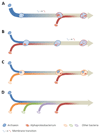Symbiosis in eukaryotic evolution
- PMID: 28254477
- PMCID: PMC5638015
- DOI: 10.1016/j.jtbi.2017.02.031
Symbiosis in eukaryotic evolution
Abstract
Fifty years ago, Lynn Margulis, inspiring in early twentieth-century ideas that put forward a symbiotic origin for some eukaryotic organelles, proposed a unified theory for the origin of the eukaryotic cell based on symbiosis as evolutionary mechanism. Margulis was profoundly aware of the importance of symbiosis in the natural microbial world and anticipated the evolutionary significance that integrated cooperative interactions might have as mechanism to increase cellular complexity. Today, we have started fully appreciating the vast extent of microbial diversity and the importance of syntrophic metabolic cooperation in natural ecosystems, especially in sediments and microbial mats. Also, not only the symbiogenetic origin of mitochondria and chloroplasts has been clearly demonstrated, but improvement in phylogenomic methods combined with recent discoveries of archaeal lineages more closely related to eukaryotes further support the symbiogenetic origin of the eukaryotic cell. Margulis left us in legacy the idea of 'eukaryogenesis by symbiogenesis'. Although this has been largely verified, when, where, and specifically how eukaryotic cells evolved are yet unclear. Here, we shortly review current knowledge about symbiotic interactions in the microbial world and their evolutionary impact, the status of eukaryogenetic models and the current challenges and perspectives ahead to reconstruct the evolutionary path to eukaryotes.
Keywords: Archaea; Eukaryogenesis; Eukaryotic origins; Mitochondria; Symbiosis; Syntrophy.
Copyright © 2017 Elsevier Ltd. All rights reserved.
Figures


References
-
- Adl SM, Simpson AG, Farmer MA, Andersen RA, Anderson OR, Barta JR, Bowser SS, Brugerolle G, Fensome RA, Fredericq S, James TY, et al. The new higher level classification of eukaryotes with emphasis on the taxonomy of protists. J Eukaryot Microbiol. 2005;52:399–451. - PubMed
-
- Andersson SG, Zomorodipour A, Andersson JO, Sicheritz-Ponten T, Alsmark UC, Podowski RM, Naslund AK, Eriksson AS, Winkler HH, Kurland CG. The genome sequence of Rickettsia prowazekii and the origin of mitochondria. Nature. 1998;396:133–40. - PubMed
-
- Archibald JM. The puzzle of plastid evolution. Curr Biol. 2009;19:R81–88. - PubMed
-
- Awramik SM. The oldest records of photosynthesis. Photosynth Res. 1992;33:75–89. - PubMed
-
- Baker BJ, Saw JH, Lind AE, Lazar CS, Hinrichs KU, Teske AP, Ettema TJ. Genomic inference of the metabolism of cosmopolitan subsurface Archaea, Hadesarchaea. Nat Microbiol. 2016;1:16002. - PubMed
Publication types
MeSH terms
Grants and funding
LinkOut - more resources
Full Text Sources
Other Literature Sources

